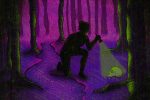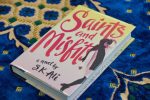Murder mystery novels certainly keep the literary world on its toes. While I’m a fan of all things fantasy and science fiction, there’s nothing like diving deep into an imaginary world where the reader becomes the puzzle solver, trying to piece together every clue and strand of information thrown their way.
An amazing addition to a mystery lover’s bookshelf is “Truly, Devious” by New York Times’ best-selling author Maureen Johnson. With elements similar to the works of Agatha Christie and E. Lockhart, this murder mystery is the perfect combination of adventure and history.
The Plot
Early 20th-century tycoon Albert Ellingham has more money than he can spend and an amazing idea: a school filled with riddles, hidden passageways and tricks at every turn. He constructs his own personal playground where everything is a game: Ellingham Academy.
Soon the academy becomes home to a game of its own: one of the most mysterious unsolved murders in history. Ellingham’s wife and daughter were kidnapped, with his wife’s body showing up and his daughter’s never to be found. The only clue left behind is a riddle describing methods of murder, signed “Truly, Devious.”
Flash forward to the present. Stevie Bell is about to enter her first year at Ellingham Academy, where students are the best of the best. With published authors, engineers and even movie stars as classmates, Stevie’s talent lurks under the shadows: she’s going to solve the Ellingham murder case.
Easier said than done, though, as Stevie slowly tries to adjust to this new school life away from home. The stress of passing anatomy combined with the mystery of the reserved boy who lives upstairs has distracted Stevie from solving the case.
Then suddenly, history seems to begin repeating itself at Ellingham when Stevie receives a note from who she suspects to be Truly, Devious. And then, a student disappears. Has Truly, Devious returned decades later?
The book alternates from the present story of Stevie to flashbacks of the night of the Ellingham murders, narrating from the point of view of various crime witnesses. Readers anxiously try to absorb every clue, but in the end, are left on a cliffhanger. With no conclusion or potential suspects for the crimes, readers are led to Johnson’s sequel “The Vanishing Stair.”
Why This Book Is Important
Especially for the YA audience that “Truly, Devious” is geared toward, the book’s racial, sexual and cultural representation is crucial. Stevie’s close friends, for instance, represent diverse backgrounds and beliefs. Her best friend, Janelle, is a black lesbian whose partner prefers the pronouns they/them, and her friend, Nate, fails to respond to social cues and is almost non-verbal in social situations. There are also secondary characters, like a student who wears a hijab and another in a wheelchair, who serve to represent other groups.
The best thing about this representation is that Johnson throws it in so casually. There is never a conversation about Janelle and her girlfriend or her sexuality. Instead, it’s just something that Stevie acknowledged and moved on with the mystery of the story. Having this representation and portraying it in such a casual manner can make younger readers feel immensely more comfortable in their own skin. Even though the representation isn’t the preface of the story, the fact that diversity is present speaks volumes.
The Verdict
Despite being a lover of reading, it takes me an awfully long time to really get into a book. I’m talking five or six chapters before I’m hooked. But with “Truly, Devious,” I was pulled in immediately after the first chapter. Johnson definitely knows how to get her readers hooked, especially by starting the story with a murder.
Right off the bat, the intensity was present and I couldn’t wait to see what was in store. I felt this same eagerness throughout the entire book, as Johnson created a roller-coaster of tension and emotion. Just when things seem to calm, Stevie finds more clues and chaos ensues.
By portraying life through Stevie’s eyes, Johnson strings her readers along as if they were solving a mystery themselves. Readers discover things along with Stevie, and can’t see ahead beyond her frame of vision, making the immersion of the story so much more realistic.
Even more realistic is the fact that Stevie is not a non-stop crime-solving machine. She’s a high school freshman dealing with all the typical experiences and emotions that teenage girls face. She’s desperately trying to find a place where she belongs in the school’s social setting, and trying to adjust to her new schedule and life, all while keeping her emotions under bay about a boy who sends her mixed signals. Even though a fictitious mystery is present, the circumstances make it feel realistic.
Audiences will resonate well with Stevie and her quest to find stability in the social scene. They will laugh at the hilarious dialogue between Stevie and her friends and be on the edge of their seats at the end of every chapter. This book is a serious case of “just one more chapter and then I’ll finish,” more like “I’ll finish when I’ve read every chapter.” A story that leaves readers not wanting to walk away is an amazing feat in and of itself.
While some mysteries can be extremely predictable, I was taken through the entire story with no concrete idea of who could have committed the murders. I’m still left scratching my head at who the suspect could, patiently waiting to read Johnson’s sequel.
“The Vanishing Stair” holds a lot of promise and will hopefully pick up on the cliffhanger that readers were left on (no spoilers). Maureen Johnson has perfectly crafted a world full of adventure and clues for younger generations that didn’t necessary have the chance to get into Sherlock Holmes or Agatha Christie. This is a new era of mystery and the games are about to begin.
















